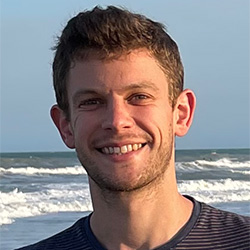How an ESAM Graduate Applies Math to COVID-19 Transmission
Josh Levy (PhD ’21) uses skills learned at Northwestern to track the coronavirus
Interdisciplinary research is a hallmark of the Department of Engineering Sciences and Applied Mathematics (ESAM) at Northwestern Engineering.

Josh Levy (PhD ’21) is applying that experience to help answer some of the world’s biggest questions.
Currently working at Scripps Research in San Diego in the lab of researcher Kristian Andersen, Levy and his colleagues are investigating COVID-19 and how it can be traced.
“One of the biggest things I learned in ESAM, because it’s very interdisciplinary, is to be comfortable diving into the biology not necessarily knowing how you’re going to use math or a quantitative framework to answer some particular question,” Levy said. “It’s often best to just dive fully into understanding the biological question at hand, and once acquainted one can start developing the necessary frameworks and methods that can actually solve the problem.”
One recent collaboration with researchers at the University of California, San Diego showed how genomic sequencing of wastewater could enable early detection of emerging variants of the coronavirus. In the paper “Wastewater Sequencing Reveals Early Cryptic SARS-CoV-2 Variant Transmission” published July 7 in Nature, Levy and his team demonstrated how that process could be enhanced with the deployment and development of virus concentration protocols and deconvolution software that fully resolves multiple virus strains from wastewater.
Levy’s role was computational, using data from experiments and a new mathematical method for deconvolving sequence mixture data to chart and trace infections in the community.
“This provided a really rich dataset for understanding virus dynamics on campus and the broader community, and can be applied to other places,” Levy said.
Levy and colleagues also used their skills to conclude that the Huanan Seafood Market in Wuhan, China, was the epicenter of the pandemic. In the paper “The Huanan Seafood Wholesale Market in Wuhan was the Early Epicenter of the COVID-19 Pandemic,” published July 26 in Science, the authors discussed how “live SARS-CoV-2 susceptible mammals were sold at the market in late 2019 and, within the market, SARS-CoV-2-positive environmental samples were spatially associated with vendors selling live mammals,” which eventually led to the coronavirus’ worldwide spread.
This work’s implications are significant, as it could help mitigate the next outbreak before it turns into something like the COVID-19 pandemic. Levy and the team had to overcome numerous obstacles to produce this work, including acquiring environmental sampling data from the market and scouring social media for information about the Huanan Market.
“Having more data upstream of the market will help answer key questions on how outbreaks like this get started,” Levy said. “How does the live wildlife trade, how does climate change, how does encroachment on wild habitats, how do all of these things play a role in the increased transmission of viruses to humans?”
